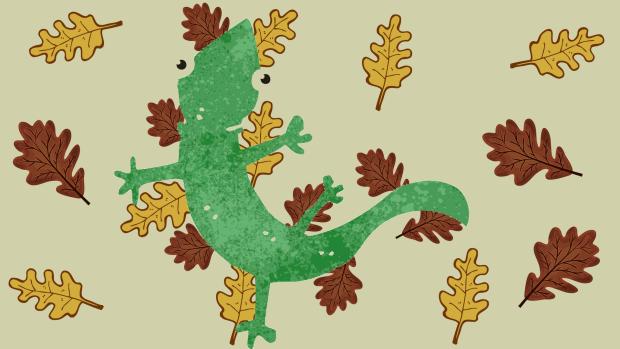
Illustration : Purabi Deshpande / Research Matters
India now has three new species of bent-toed geckos, or Cyrtodactylus (Geckoella), from the Mysore Plateau and human-modified landscapes of Maharashtra, which are the first new members of the group to be described from India in130 years.
Geckos are lizards known from tropical and subtropical habitats globally. Most geckos are active during the night and are found in a variety of different habitats including forests, trees, mountains, plateaus, etc. Geckoella (a subgenus of Cyrtodactylus) are a group of bent toed, ground dwelling geckos endemic to India and Sri Lanka. They fall under the family Gekkonidae, the largest family of geckos in the world.
Previously, there were 7 species of Geckoella described between 1870 and 1885. One more species was described from Sri Lanka in 1943. These three new species from India has now increased the total Geckoella species count to 11 after 130 years, thanks to the efforts of herpetologist and post doctoral researcher Dr. Ishan Agarwal from the Department of Biology, Villanova University, USA, who is behind the discovery of the new Geckoella species in India.
All the three new species belongs to the Cytrodactylus genus and are grouped under the C.collegalensis species complex – the most widely distributed Geckoella species complex in southern and western peninsular India. “A species complex is a group of closely related species that are very similar in how they look (morphology) and can be difficult to differentiate. Usually, this implies that a taxonomic revision of the group is also pending”, says Dr. Agarwal.
The first of these 3 species, Cytrodactylus varadagirii (Giri’s Geckoella) was described as a new species in September 2016. This description was based on museum specimens from western and central India. It is named after Dr. Varad Giri, former Curator of Bombay National History Society (BNHS) honouring his contributions to Indian herpetology.
The research team involved in this discovery included scientists from Villanova University, USA, Centre for Ecological Sciences, Indian Institute of Science, Bangalore, National Centre for Biological Sciences, Bangalore, Tata Institute of Fundamental Research, Bangalore, Bombay National History Society (BNHS), Mumbai and the Department of Life Sciences, The Natural History Museum (BMNH), London. The researchers described the new species based on comparisons between the molecular and morphological data obtained from specimens of all the species in the C.collegalensis species complex.
Cyrtodactylus varadagirii is a small, ground dwelling gecko active at night. Its length is about 5.6 cm (excluding the tail). Unlike other Geckoella species, this species is found to be present in areas outside forests such as human modified landscapes. This species also has a conspicuous colour pattern and is found in Mumbai, which is one of the oldest and largest cities in India. It is also the only known Geckoella species with a wide distribution range, of greater than 100 – 200 kms, and yet has a patchy distribution all over the range.
The other 2 species were collectively described by Dr. Agarwal in November 2016. They are named as Cytrodactylus srilekhae (the Bangalore Geckoella) and Cytrodactylus rishivalleyensis (the Rishi Valley Geckoella). Both these species are described from the Mysore Plateau which covers parts of Karnataka, Andhra Pradhesh and Tamil Nadu. Dr. Agarwal has named the Bangalore Geckoella after his mother Srilekha Agarwal in recognition of the inspiration she has provided him. He has named the Rishi Valley Geckoella after Rishi Valley in Mysore which is the locality of the species and also the place where he did his schooling.
Both these species are small, ground dwelling nocturnal geckos, of about 5cm in length (excluding the tail). C. srilekhae is known to be found in the scrub forests of the Mysore Plateau. The distribution range is within 60 kms of Bangalore, but it has been found in elevations between 800 and 1400m. On the other hand C. rishivalleyensis is known to be found on isolated hill tops of the Mysore Plateau where the elevation is above 1000m. This species also shares the habitat with many other geckos. “This is one of the few known localities in southern India where two terrestrial geckos, Geckoella and ground dwelling Hemidactylus overlap”, says Dr. Agarwal.
All the three new species have their own distinct colouration in comparison with the previously described species. The two new endemic species of Geckoellas described in the Mysore plateau has increased the number of endemic geckos in the region from 3 to 5. The first species of this C.collegalensis complex is reported to be described 150 years ago. According to the authors, the possible reasons for missing out on these species till now are a lack of knowledge on Indian Geckoella, underrepresentation of its specimens in museum collections, inadequate survey efforts and poor taxonomic practices.
What could be done to counter such problems? “There needs to be large scale biodiversity survey effort across India and across taxonomic groups, with large collections of specimens. These specimens need to be DNA sequenced and their morphology should be studied, in addition to studying the morphology of existing specimens and holotypes in museums across the world”, recommends Dr. Agarwal. But could there be more such unidentified Geckoella species in India? “There are at least 20 to 30 more species waiting out there to be discovered”, he signs off with hopes of finding them some day.





